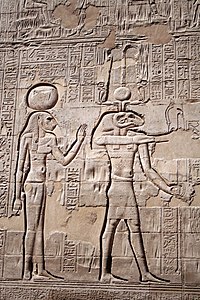Khnum
| Khnum in hieroglyphics | |||||||||
|---|---|---|---|---|---|---|---|---|---|
| Ideograms |
|
||||||||
| mostly |
Khnum / Chenmu / Chenemu ẖnmw |
||||||||
| or with determinative |
|
||||||||
| ditto too |
|
||||||||
| Greek | Χνουμ, Χνουβιζ | ||||||||
| Menhit (left) and Khnum (right) on the outer wall of the Temple of Esna | |||||||||
Khnum (actually Chenemu ) is an ancient Egyptian God, since the Old Kingdom is occupied. The role assigned to him in Egyptian mythology as Neb-Qebehu ("Lord of Qebehu ") was only assumed by Khnum since the New Kingdom , although his earliest evidence in connection with Elephantine is attested in the Old Kingdom. There he did not appear initially as a creation deity, but as a "helper of the Sopdet and the Satis ".
In the course of the Middle Kingdom , a separate cult of the Khnum becomes recognizable with regard to the flood of the Nile , as he has not been mentioned in his previous function since the new construction of the Satis Temple. It was not until the 19th dynasty of the New Kingdom that Khnum took on the title of Neb-Abu ("Lord of Elephantine"). Previously, the goddess Satis alone was called "Mistress of Elephantine".
Reading and pronunciation of the name
The reading and pronunciation of Khnum is known from the Greek. Every language has historical spellings that have little to do with logic - here "Khnum" instead of "Chenemu", although the 'w' of the transcription is clearly at the end of the word, and the hieroglyphs actually written are actually assigned as "Chenem-u" would be read. Was pronounced Chenemu probably Xanamu . In the Arabic language this corresponds to yanam , which is still translated today as “sheep”. The god's name can therefore also refer to the sheep.
presentation
In earlier times it was exclusively animal-shaped, but it has been in use since around 2400 BC. BC depicted as a ram-headed god in human form.
Meaning and places of worship
Khnum was above all a creator god who created gods and people as well as animals and plants on the potter's wheel and who could bring them to life with the help of a magic wand. As god of fertility and husband of Heket , he was lord of conception and birth.
Since the New Kingdom, Khnum has been the patron god of Elephantine and the area around the 1st cataract, which is why his later common nickname was "Lord of the cataract" ( Neb-Qebehu ). Here he formed the triad of Elephantine with Satis and their daughter Anukis since the New Kingdom . In Esna, however, the triad consisted of Khnum, Menhit and the son Heka . During the first interim period ( 8th dynasty ) he merged with the sun god Re to Khnum-Re through the general sun cult , first documented in the temple of Debod .
Khnum was venerated in many places in Upper Egypt and Nubia , less often in Lower Egypt . The most important cult centers include: Elephantine, Bigge bei Philae , Esna and Hut-wer . Other cult centers of the god were in Shas-hotep (Rifeh), Herwer (Khnum, "Lord of Herwer"), in the 16th Upper Egyptian Gau and at Tarchan in the first Lower Egyptian Gau.
See also
literature
- Ahmad Muhammad Badawi: The God Khnum. Augustin, Glückstadt 1937.
- Hans Bonnet : Khnum. In: Lexicon of Egyptian Religious History. Nikol, Hamburg 2000, ISBN 3-937872-08-6 , pp. 135-140.
- Khnum. In: Helmut Freydank et al .: Lexicon of the Ancient Orient: Egypt, India, China, Western Asia. VMA, Wiesbaden 1997, ISBN 3-928127-40-3 .
- Wolfgang Helck , Eberhard Otto : Chnum. In: Small Lexicon of Egyptology. Harrassowitz, Wiesbaden 1999, ISBN 3-447-04027-0 , p. 61f.
Web links
Individual evidence
- ^ Adolf Erman, Hermann Grapow (ed.): Dictionary of the Egyptian language . Volume III, Akademie-Verlag, Berlin 1926–1961, p. 381.
